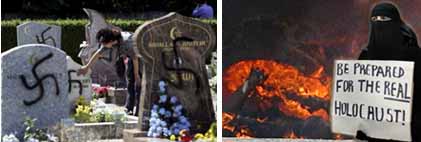
The tension over the now infamous, even if not very funny, Danish cartoon depictions of the Prophet Muhammad has taken on a grave dimension, specifically the desecration of a number of Muslim graves in western Denmark. There are two lessons that immediately come to mind about this latest twist, but first the story as reported in The Washington Post:
Vandals in Denmark Strike Muslim Graves
By Kevin Sullivan
Washington Post Foreign Service
Monday, February 13, 2006; Page A16COPENHAGEN, Feb. 12 — About 25 Muslim graves in western Denmark were vandalized late Saturday night, bringing swift condemnation from Prime Minister Anders Fogh Rasmussen as tensions simmer from a Danish newspaper’s publication last year of cartoons of the Islamic prophet Muhammad.
“I strongly condemn this disgraceful act, and I deeply regret the desecration of Muslim graves,†Rasmussen said in a statement released by his office Sunday night. “I have made it clear that the Danish government condemns any expression or any action which offends people’s religious feelings.â€
Ahmed Akkari, a prominent Muslim leader in Denmark, said he was “happy†that Rasmussen had issued the statement so quickly. He said that in similar cases in the past, “nothing happened.†Akkari said he believed that those who vandalized the Muslim graves in the city of Esbjerg, in Jutland, west of Copenhagen, “do not represent the Danish people’s general attitude.â€
Even the dead are not allowed to rest in peace when anger escalates out of control. There is a tit-for-tatness going on here that defies rationality but is not unique by any means to political history anywhere. The main response of the European and American publics has been one of surprise that Muslims would be so offended by a bunch of cartoons in an obscure newspaper. It is not that such sacrilege would have been tolerated in the Christian past, but that the secular side of modernity has taken “us†beyond such provocations. The daily images of Muslims carrying placards, burning Danish flags and torching European embassies suggest that Muslims as such are over-reacting. Of course, about all we see reported here in the West is the over-reaction, not the turning over of gravestones
Meanwhile most Muslims are deeply offended that there has been such indifference to what they see as a senseless and tasteless attack on their faith, on top of all the other problems imposed upon Muslim countries. Then there are those individuals and regimes that stand to gain from stoking the coals of unrest over this issue. Several Arab governments have used the occasion to stifle freedom of the press as a way to remove a thorn in their partisan side, while beleaguered Iranian ideologues fanned the fires by calling for cartoons that ridicule the holocaust, as though Cartoongate was another Zionist conspiracy. All the more reason to have a “Muslim†bomb, perhaps (surely something to mullah over in the long run).
The latest Danish counter-response, obviously not authorized by the authorities and perhaps just the act of routine vandals taking advantage of the moment, is poignant in targeting graves. The issue becomes not just about tolerance (both the secular West tolerating Muslim sensitivities about their Prophet and Muslims tolerating the challenges of living in a secular state), but the symbolic equivalent of ethnic cleansing. Knocking over graves goes beyond complaints about the failure of Muslims to adapt in a multicultural or secular setting to a clear statement that Muslims are not welcome even when they are dead.
The danger in all these acts and counter-acts is that lines are not just being drawn in the sand but also carved into stone. I am reminded of the words of Edmund Burke that all that is necessary for evil to triumph is for good men to do nothing. In the current crisis we might paraphrase this to note that the only thing necessary for the current escalation to continue to rage out of control is for the voice of tolerance on all sides not to be shouted and not to be heard. Those voices are out there, if we look.
Daniel Martin Varisco